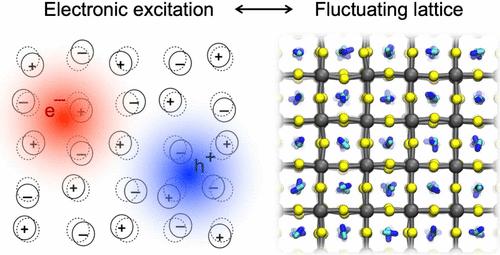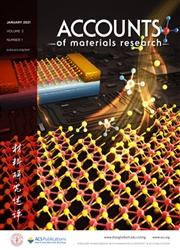Theoretical Insights into the Role of Lattice Fluctuations on the Excited Behavior of Lead Halide Perovskites
IF 14.7
Q1 CHEMISTRY, MULTIDISCIPLINARY
引用次数: 0
Abstract
Lead halide perovskites have been extensively studied as a class of materials with unique optoelectronic properties. A fundamental aspect that governs optical and electronic behaviors within these materials is the intricate coupling between charges and their surrounding lattice. Unravelling the role of charge-lattice interactions in the optoelectronic properties in lead halide perovskites is necessary to understand their photophysics. Unlike traditional semiconductors where a harmonic approximation often suffices to capture lattice fluctuations, lead halide perovskites have a significant anharmonicity attributed to the rocking and tilting motions of the inorganic framework. Thus, while there is broad consensus on the importance of the structural deformations and polar fluctuations on the behavior of charge carriers and quasiparticles, the strongly anharmonic nature of these fluctuations and their strong interactions render theoretical descriptions of lead halide perovskites challenging. In this Account, we review our recent efforts to understand how the soft, polar lattice of this class of materials alters their excited state properties. We highlight the influence of the lattice on static properties by examining the quasiparticle binding energies and fine structure. With perovskite nanocrystals, we discuss how incorporating lattice distortion is essential for accurately defining the exciton fine structure. By considering lattices across various dimensionalities, we are able to illustrate that the energetics of excitons and their complexes are significantly modulated by polaron formation. Beyond energetics, we also delve into how the lattice impacts the dynamic properties of quasi-particles. The mobilities of charge carriers are studied with various charge-lattice coupling models, and the recombination rate calculation demonstrates the molecular origin on the peculiar feature in the lifetime of charge carriers in these materials. In addition, we address how lattice vibrations themselves relax upon excitation from charge-lattice coupling. Throughout, these examples are aimed at characterizing the interplay between lattice fluctuations and optoelectronic properties of lead halide perovskites and are reviewed in the context of the effective models we have built and the novel theoretical methods we have developed to understand bulk crystalline materials, as well as nanostructures and lower dimensionality lattices. By integrating theoretical advances with experimental observations, the perspective we detail in this Account provides a comprehensive picture that serves as both design principles for optoelectronic materials and a set of theoretical tools to study them when charge-lattice interactions are important. These insights may further guide the development of next-generation optoelectronic devices with improved efficiency and stability while also inspiring new research directions to explore emerging quantum phenomena in these materials.

晶格波动对卤化铅钙钛矿激发行为作用的理论见解
卤化铅钙钛矿作为一类具有独特光电性能的材料,受到了广泛的研究。控制这些材料中光学和电子行为的一个基本方面是电荷与其周围晶格之间复杂的耦合。揭示电荷-晶格相互作用在卤化铅钙钛矿光电特性中的作用是理解其光物理的必要条件。与谐波近似通常足以捕获晶格波动的传统半导体不同,卤化铅钙钛矿由于无机框架的摇摆和倾斜运动而具有显着的非谐波性。因此,虽然对结构变形和极性波动对载流子和准粒子行为的重要性有广泛的共识,但这些波动的强非调和性质及其强相互作用使得卤化铅钙钛矿的理论描述具有挑战性。在这篇文章中,我们回顾了我们最近的努力,以了解这类材料的软极性晶格如何改变它们的激发态性质。我们通过观察准粒子结合能和精细结构来强调晶格对静态性质的影响。对于钙钛矿纳米晶体,我们讨论了如何结合晶格畸变是准确定义激子精细结构的必要条件。通过考虑不同维度的晶格,我们能够说明激子及其复合物的能量学受到极化子形成的显著调节。除了能量学,我们还深入研究了晶格如何影响准粒子的动态特性。用不同的电荷-晶格耦合模型研究了载流子的迁移率,并计算了复合速率,证明了这些材料中载流子寿命特有特征的分子来源。此外,我们讨论了晶格振动本身如何在电荷-晶格耦合的激励下松弛。总之,这些例子旨在描述卤化铅钙钛矿的晶格波动与光电特性之间的相互作用,并在我们建立的有效模型和我们开发的新的理论方法的背景下进行了回顾,以理解块状晶体材料,以及纳米结构和低维晶格。通过将理论进展与实验观察相结合,我们在本报告中详细介绍的观点提供了一个全面的图景,既可以作为光电材料的设计原则,也可以作为一套理论工具,在电荷-晶格相互作用重要时研究它们。这些见解可能会进一步指导下一代光电器件的发展,提高效率和稳定性,同时也会激发新的研究方向,探索这些材料中新兴的量子现象。
本文章由计算机程序翻译,如有差异,请以英文原文为准。
求助全文
约1分钟内获得全文
求助全文

 求助内容:
求助内容: 应助结果提醒方式:
应助结果提醒方式:


